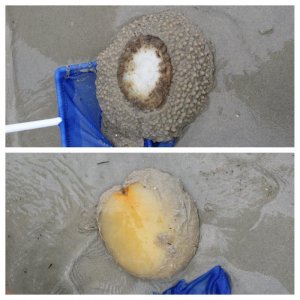Kittiescat
New member
Found in Jupiter FL, tide had gone out from under it, only took these two photos as we were hurrying to get it back into the water. It was still alive. Was 9-10 inches across and was very heavy/dense orange area was very slick and the white area on the other side was rigid like the back of a barnacle. It is really bothering me not to be able to identify this.
I can feel my sanity slowly ebbing away like the tide out from under this creature!
Seriously pass the photo on if you think it might help solve this riddle.
I can feel my sanity slowly ebbing away like the tide out from under this creature!
Seriously pass the photo on if you think it might help solve this riddle.

